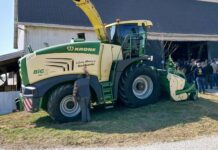PAINESVILLE, Ohio – A new method of 4-H livestock judging is moving across the country, and it is coming into Ohio through Lake County.
The “systems analysis” method of market livestock project evaluation has been adopted by the Lake County junior fair livestock committee and will be used this summer at the Lake County Fair.
It is an approach that attempts to put more objectivity into the subjectivity of judging and doesn’t encourage the ethics violations that sometimes creep into the business of “showing” animals.
But it is also an approach that attempts to answer the perennial question asked by young people after they leave the show ring, “What did I do wrong?”
Lake County – home to nurseries and vineyards, but few cows and pigs – might seem an unusual place for a new method of livestock judging to be judged in Ohio.
But, according to Jim Howard, vice president of the livestock committee, it is because Lake County is not typically agricultural that the committee was open to this new approach.
Not farm kids.
In general, there are 4-H members taking market projects who do not live on farms where livestock is raised, and really have little idea how to raise a market animal. In Lake County, there are few members who even live on farms.
What the systems approach can do for the 100 or so youth who exhibit through Lake County 4-H, Howard said, is put more education into the way the project is conducted, and provide them with the kind of feedback that will allow them to understand the role of goal setting, planning, and working toward achieving that goal.
The system is designed to reward 4-H youth for what they learn and for the effort they put into their project during the entire project period.
Requires scorecard.
Judging is done by a standardized scorecard that evaluates numerically and systematically the lean yield of the individual animal; the traditional confirmation qualities of frame, muscling, trimness, and correctness, with emphasis on how these qualities are evaluated by the livestock industry; and on weight gain and finishing.
The process requires a preliminary weigh-in where the starting weight of each project animal is recorded.
The educational portion emphasizes that the young person learn more about industry standards; know how to look for and select an animal that can meet those standards in the set time period; and establish and meet the intermediate goals that will bring the animal to top condition at the time it will be shown.
Raising food.
The emphasis is keeping the young person’s eye firmly set on the end goal – raising food for the consumer market.
There is the option of using ultrasound to measure ribeye and fat, but that is not required.
The judge in any livestock evaluation is really assessing carcass characteristics, said Jodi Black, Ohio State Extension 4-H livestock program specialist.
In this system, however, she said, since the judge is filling out a score card for each animal in order to place the entries numerically rather than subjectively, the judge has to look more closely at each animal.
“Because the judge will be evaluating every animal, not just the top four or five,” Black said. “The system encourages better communication.”
Rewards feeding.
“This system will also tend to penalize the ‘holding’ project in favor of the true ‘feeding’ project,” Black said. “If someone buys a big animal to begin with, and then just holds and maintains it over the project period, they will not do as well as the project that starts as a young animal and is fed to meet finishing goals.”
Having feeding and development goals is given heavy emphasis in the official scoring.
And because the score is a composite of all of the carcass and confirmation factors, there is no possibility of a judge getting carried away by an exceptionally beautiful animal.
“I’m not sure that the same animals wouldn’t win with this judging system that are winning now,” Black said. “We already have a high quality group of animals being shown.”
Better next year.
But since each youth receives a written scorecard that tells him where the animal did not meet judging criteria, they have an opportunity of learning from their mistakes and coming back with a better project the next year.
Started in Idaho.
The systems approach was developed in Idaho by two brothers who are both extension educators and agents, Gene and Chad Gibson.
Gene Gibson, now located in Benewah County at Sandpoint, said he and his brother started searching in 1974 for ways to align 4-H market projects to the “real world” and to do a better job of educating youth about the livestock industry.
They began introducing the system they developed in 1982, and wrote their first publication in 1989.
Now, they have conducted judging training workshops all over the West, have presented at two 4-H youth ethics conferences, and have held their own national training conferences.
Ohio State’s Black was one of the 4-H program specialists who attending the Idaho conference last fall.
The method has been adopted by some counties in 17 states. In Idaho, it is now used in 70 percent of the state’s counties.
Only the Canadian province of Alberta, just north of Idaho, where the province has the power to dictate the method, has adopted it throughout.
Watch Lake County.
When asked if she was promoting the idea that Ohio counties should use this new judging method, Black said she was waiting to see what happens in Lake County this summer.
Gibson said his experience in Idaho is that the quality of livestock being shown in the county fairs made a 50 percent improvement in quality within three years.
“There is a building quality to this system,” he said. “The content of the evaluation tells you what you have to do to get there, if you will do it.”
* * *
Systems approach: What to consider
LEGITIMATE CONCERNS
* How do you get beginning weights to figure an appropriate average daily gain?
All animals are brought together to begin the project at an initial weight day, which can serve as an opportunity to conduct educational programs.
* What happens if a judge doesn’t want to use the systems approach evaluation card?
Such a judge must be given a choice to use the card or not participate in the show. It usually takes only one or two classes for a judge to understand how it makes their job much easier and they do a good job with the process.
* Can a systems approach show still retain the traditional show atmosphere?
Systems approach show ring procedures are conducted in much the same manner as traditional shows.
ILLEGITIMATE COMMENTS
* The card system is nothing more than a gain contest.
Not hardly. The maximum points delegated to the average daily gain section of the evaluation card are easily attainable by a quality animal under good management. The purpose of the section of the card is first to reward good management skill and effort and secondly to discourage the “holding” of the animals.
* I can screw up the average daily gain by sucking my animal back at the first weigh-in.
Weighing conditions at the initial weigh-in are such that animals are weighed full. Even if someone wants to cheat on weights , the limits on emphasis for gain does not allow them an advantage over good management by another member.
* This is just a commercial steer contest.
The systems approach is operated just like a regular livestock show with animals worked in the arena in the same manner. Showmanship skills and fitting skills are important. The animal manipulation games are simply eliminated and replaced with real world animal management and evaluation based on commercial steer production.
* Livestock shows don’t and shouldn’t have anything to do with real world agriculture.
It is extremely important that show animals be good representatives of their respective industry. Real world animal agriculture and livestock shows are different, but they need to parallel each other instead of run in opposite directions. The more that livestock shows are parallel to real world agriculture, the less problems are built into the show such as diuretic use, severe holding of animals, and fabrication of animals resulting in production of a low quality product unacceptable to or unfit for the consumer.
* The audience won’t understand what a judge is doing using a card to place a class.
Use of simple education materials allows the audience to know exactly what the judge is doing. This also allows the audience to make the same estimates as the judge and contrast their reasoning with that of the judge. The systems approach removes all of the mystery and speculation as to the judge’s bias or motives in a traditional show.
* You can’t expect young kids to achieve the same standards as industry professionals.
We often find that kids will do exactly what we expect. Data from shows that have initiated a system approach indicate that kids can and do attain industry standards once they know what’s expected of them.
(You can contact Jackie Cummins at 1-800-837-3419, ext. 23, or by e-mail at jcummins@farmanddairy.com.)
Get 4 Weeks of Farm and Dairy Home Delivered









